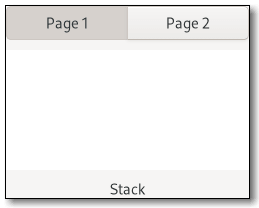Package: gtk
Class gtk:stack
Superclassesgtk:widget, gobject:initially-unowned, gtk:accessible, gtk:buildable, gtk:constraint-target, gobject:object, common-lisp:standard-object, common-lisp:t Documented Subclasses
None
Direct SlotsDetails The gtk:stack widget is a container which only shows one of its
children at a time. In contrast to the gtk:notebook widget, the gtk:stack widget
does not provide a means for users to change the visible child. Instead, the gtk:stack-switcher widget can be used with the gtk:stack
widget to provide this functionality.  Figure: GtkStack Transitions between pages can be animated as slides or fades. This can be controlled with the gtk:stack-transition-type function. These animations respect the gtk-enable-animations setting. The gtk:stack widget maintains a gtk:stack-page object for each added child widget, which holds additional per-child properties. You obtain the gtk:stack-page object for a child widget with the gtk:stack-page function. GtkStack as GtkBuildable
<object class="GtkStack" id="stack">
<child>
<object class="GtkStackPage">
<property name="name">page1</property>
<property name="title">In the beginning…</property>
<property name="child">
<object class="GtkLabel">
<property name="label">It was dark</property>
</object>
</property>
</object>
</child> CSS nodesAccessibility | Returned bySlot Access FunctionsInherited Slot Access FunctionsSee also |
2025-06-29